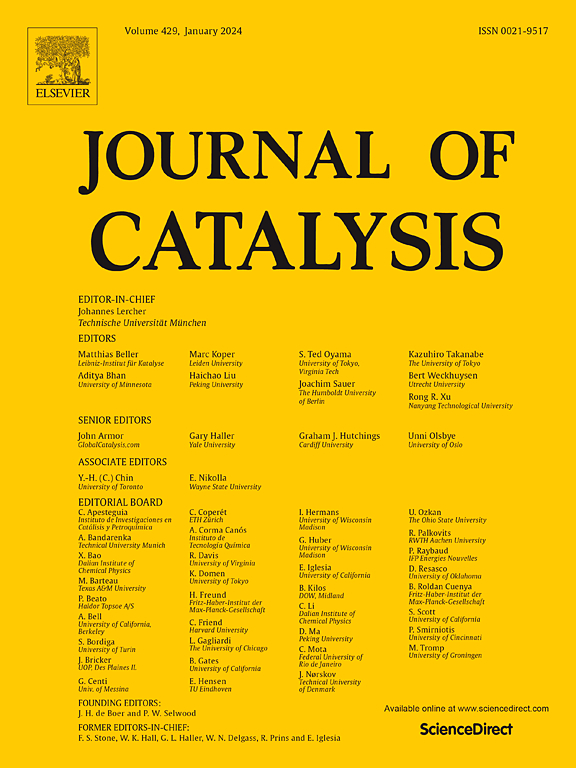Interfacial charge transfer bridge on SrTiO3 crystal boosts solar water splitting
IF 6.5
1区 化学
Q2 CHEMISTRY, PHYSICAL
引用次数: 0
Abstract
SrTiO3 particulate catalysts have demonstrated significant potential in solar water splitting, making them a cost-effective solution for green hydrogen generation. However, the exorbitant total cost associated with utilizing the ultra-precious metal Rh even at content as low as 0.1 wt% for hydrogen evolution necessitates the exploration of efficient and cost-effective alternatives. In this work, we developed Pt-Ni alloy hydrogen evolution cocatalysts to substitute for Rh. We deposited them with CrOx passivation layers and CoOOH oxygen evolution cocatalysts onto the surface of the K-doped SrTiO3 crystal for overall water splitting. Studies revealed that K+ can serve as an electron accumulation center during photoexcitation and the construction of an interfacial K-O-Pt bridge can effectively facilitate the charge transfer. After optimization, Pt2Ni@CrOx/K-SrTiO3/CoOOH exhibits desirable photocatalytic overall water-splitting activity, with the apparent quantum yield (AQY) of 73.46 % (365 nm) and solar-to-hydrogen (STH) conversion efficiency of 0.54 %. This surpasses the catalytic activity of ultra-precious metal Rh and exceeds the catalytic activity of Pt-Ni alloys constructed in situ on Al-SrTiO3 surfaces. This work would facilitate the development of efficient photocatalysts to produce hydrogen economically.


SrTiO3晶体上的界面电荷转移桥促进太阳水分裂
SrTiO3颗粒催化剂在太阳能水分解中显示出巨大的潜力,使其成为一种经济有效的绿色制氢解决方案。然而,即使在含量低至0.1 wt%的情况下,利用超贵金属Rh进行氢气析出的总成本也过高,因此需要探索高效且具有成本效益的替代方案。在本工作中,我们开发了Pt-Ni合金析氢助催化剂来替代Rh。我们将它们与CrOx钝化层和CoOOH析氧助催化剂一起沉积在k掺杂SrTiO3晶体表面,以实现整体水分解。研究表明,K+在光激发过程中可以作为电子积累中心,构建K- o - pt界面桥可以有效地促进电荷转移。优化后,Pt2Ni@CrOx/K-SrTiO3/CoOOH具有良好的光催化整体水分解活性,表观量子产率(AQY)为73.46 %(365 nm),太阳能制氢(STH)转化效率为0.54 %。这超过了超贵金属Rh的催化活性,也超过了在Al-SrTiO3表面原位构建的Pt-Ni合金的催化活性。这项工作将促进高效光催化剂的发展,以经济地生产氢。
本文章由计算机程序翻译,如有差异,请以英文原文为准。
求助全文
约1分钟内获得全文
求助全文
来源期刊

Journal of Catalysis
工程技术-工程:化工
CiteScore
12.30
自引率
5.50%
发文量
447
审稿时长
31 days
期刊介绍:
The Journal of Catalysis publishes scholarly articles on both heterogeneous and homogeneous catalysis, covering a wide range of chemical transformations. These include various types of catalysis, such as those mediated by photons, plasmons, and electrons. The focus of the studies is to understand the relationship between catalytic function and the underlying chemical properties of surfaces and metal complexes.
The articles in the journal offer innovative concepts and explore the synthesis and kinetics of inorganic solids and homogeneous complexes. Furthermore, they discuss spectroscopic techniques for characterizing catalysts, investigate the interaction of probes and reacting species with catalysts, and employ theoretical methods.
The research presented in the journal should have direct relevance to the field of catalytic processes, addressing either fundamental aspects or applications of catalysis.
 求助内容:
求助内容: 应助结果提醒方式:
应助结果提醒方式:


